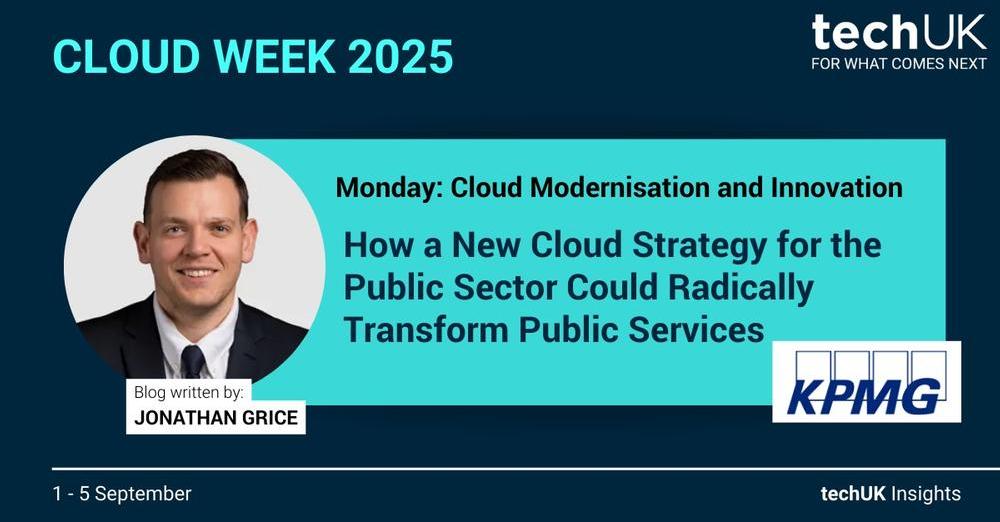How a new Cloud Strategy for the Public Sector could radically transform public services (Guest blog from KPMG)

This blog was written by Jonathan Grice, Partner and Head of Cloud - Public Sector, KPMG
For the public sector, full-and-complete cloud migration feels like an inevitability albeit one that is slowly creeping up on us.
Many organisations are compelled to move to cloud by existing systems that are unable to support current or future business needs, shifting end-user expectations around data availability and self-service, and the irreversible shift towards Software-as-a-Service (SaaS); the choice around cloud migration is increasingly one that the environment demands and is made for you. We must remember that although this process can be both daunting and complex, the benefits to cloud as default can be enormous.
Cloud is a crucial enabler for many of the broader ambitions as stated in the ‘Blueprint for Modern Digital Government’ including agentic ai and hyper personalisation of public services. Government shares this view; with its anticipated Cloud Strategy for the public sector in development and expected to cover both the speeding-up of cloud adoption and maximising its potential (both technically and crucially in the realm of public expenditure). In this piece I discuss the key pillars for how I see a public sector Cloud Strategy unfolding.
Procurement
There is a fantastic opportunity for Government to not only address the technicalities of Cloud Adoption but also how they purchase. We believe that procurement needs to evolve with the change in technologies. Current procurement processes from our experience sometimes struggle to account for cloud’s total cost of ownership. Once digital solutions have been built, there doesn’t seem to be any focus on measuring technical debt or TCO (Total Cost of Ownership). This not only includes the Cloud spend and human effort from the departments themselves but cost such as third-party systems integrator (SI) fees. Sometimes these fees make departments feel locked in or dependant on this support and there is a lack of emphasis on reducing the technical debt leading to human effort to support. With public cloud, adopting the right approach can ensure departments take full advantage of the shared responsibility model and lowering effort and cost on supporting underlying infrastructure. Consequently, many cloud migrations haven’t yielded expected savings.
Departments should help address this by embedding a FinOps mindset into procurement, emphasising continuous cost transparency and cross-functional value optimisation and pushing for more outcome-based procurement which drives “skin in the game” responses from providers.
Modernisation
Compounding the cloud waste problem is the heavy burden of legacy technology in government. It’s eye opening that many still expend much their IT budgets and staff efforts just keeping decades-old systems running, often via expensive third-party contracts. In the recent state of digital government review, it was revealed that large departments like DWP and NHS England devote 70–85% of their technology budgets to “keeping the lights on” rather than to modernisation or new services. This has been picked up in the document “A Blueprint for modern digital government” as one of the areas of improvement, particularly resetting the relationship with technology risk.
By investing in modern platforms, governments can free up substantial resources – money spent on extended support contracts, and the time/energy of skilled personnel – to focus on innovative services that directly benefit citizens. Imagine the opportunity with this level of investment back into digitising our government. By ripping off the plaster and tackling legacy tech debt and renegotiating costly contracts, governments create headroom to innovate, whether that’s developing user-friendly digital portals or deploying new tools (like AI assistants) that improve the citizen experience.
Simply moving to public cloud, in our view, isn’t the final answer. It’s about modernising and truly taking advantage of what public cloud services can offer.
FinOps
One of the most promising approaches to address cloud costs is FinOps which is best defined as “an operational framework and cultural practice which maximizes the business value of cloud and technology…”. At KPMG we firmly believe that FinOps is not merely a dedicated team or a one-time initiative – it’s a cultural shift in how engineering and product teams make decisions. In our previous Follow the Money paper, we argued that accountability is key: every cloud resource should have an owner, and every team should “follow the money” for the services they build. The long-term goal is to embed FinOps principles into daily operations such that every engineer, considers cost as a fundamental part of their workflow, just like performance or security.
Importantly, treating FinOps as a cultural mindset means aligning incentives and responsibilities. At KPMG we have managed to not only track spend and align through accountability, but we can show this spend back at the project level and, chargeback. Once a CTO or CDIO can see exactly how much a particular project is costing (including cloud spend, licences, 3rd party costs and human time) they are much better placed to make decisions around the value of that service to the organisation.
Turning FinOps theory into practice is not simple or quick. It requires concrete strategies and tools but above all else, buy-in from leadership. I think that government agencies or centralised departments such as DSIT should take a systematic approach to identify cloud spend, analyse its value, and continually optimize. DSIT has a fabulous opportunity to establish a community to bring learnings and best practices from each of the different departments and embed these into a government-wide culture of cost-awareness, increasing the value that public cloud can bring.
Communities of Practice
It’s a well-known fact that the civil service finds it difficult to not only attract, but to retain talent. We think there is a huge opportunity to drive a cross government and even interdepartmental Communities of Practice approach to not only help attract and retain curious minds who are consistently looking to learn, but to drive productivity.
What we have found at KPMG when we introduced this structure in our engineering teams was a significantly positive cross product/platform team collaboration. Teams immediately started to help each other in an enabling way by sharing solutions, code and even creating platform or product teams due to the demand on similar services across our client portfolio. This made our teams much quicker to market, lowered technical repetition/debt and lowered not only security issues but also cost.
Having communities of practice will provide civil servants the ability to support different departments, understand their needs and potentially help resolve the career path and progression opportunities identified by the Secretary of State in the recent State of Digital Government Review.
Conclusion
Government leaders face a dual mandate: accelerate digital transformation to improve citizen services, while keeping technology spending under control to respect taxpayer funds. But I don’t think these goals are conflicting, I think are deeply complementary. By doubling down on identifying and addressing cloud spend, governments can generate savings that directly fund service improvements.
So what should governments do to capitalize on this opportunity?
- Make Cloud Spend a Strategic Priority - Treat cloud costs like any other critical line of public expenditure. Build full visibility across departments, embed a culture of cost-aware engineering, and ensure accountability sits with both civil servants and delivery partners.
- Modernise, Don’t Just Migrate - Shift investment away from “keeping the lights on” towards replacing or refactoring legacy systems. A clear, funded roadmap for retiring outdated technology will free budgets and skills to focus on innovation.
- Reform Procurement for the Cloud Era - Evolve procurement to reflect the total cost of ownership — including cloud services, licences, SI fees, and human effort. Move towards outcome-based contracts and shared-savings models that incentivise efficiency and value.
- Invest in Communities of Practice - Support cross-government communities that share expertise, accelerate learning, and create attractive career paths. These networks will help government attract and retain the digital talent needed to deliver sustainable change.
Departments should measure and communicate the impact of these efforts, quantifying the savings from joined-up procurement, legacy modernisation and cloud optimisation and then visibly directing those savings into higher-value activities that make government services more responsive, reliable, and citizen-centric.
Sources: The content of this paper is informed by a variety of sources, including the UK government’s Blueprint for Modern Digital Government and State of Digital Government Review, which highlight the need for cost-efficient digital reform; industry research such as Flexera’s State of the Cloud reports on cloud waste and GDS’s cloud cost dashboard initiative; Flexera CloudZero report and our own KPMG white paper Follow the Money, which underscores the importance of accountability in cloud spending. Also “A blueprint for modern digital government” https://www.gov.uk/government/publications/a-blueprint-for-modern-digital-government/a-blueprint-for-modern-digital-government-html . These sources and examples collectively reinforce the strategies and recommendations presented here.
For more information please contact:





